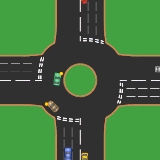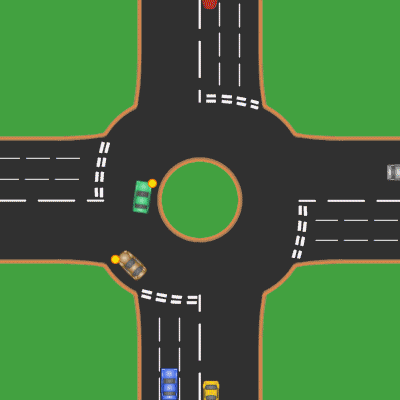
Microsimulation
Encyclopedia
Introduction
Microsimulation (from microanalytic simulation) is a category of computerized analytical tools that perform highly detailed analysis of activities such as highway traffic flowing through an intersection, financial transactions, or pathogens spreading disease through a population. Microsimulation is often used to evaluate the effects of proposed interventions before they are implemented in the real world. For example, a traffic microsimulation model could be used to evaluate the effectiveness of lengthening a turn lane at an intersection, and thus help decide whether it is worth spending money on actually lengthening the lane.Microsimulation can be distinguished from other types of computer modeling in that it looks at the interaction of individual "units" such as people or vehicles. Each unit is treated as an autonomous entity and the interaction of the units is allowed vary depending on stochastic (randomized) parameters. These parameters are intended to represent individual preferences and tendencies. For example, in a traffic model some drivers are cautious and wait for a large gap before turning, while others are aggressive and accept small gaps. Similarly, in a public health model individuals could vary in their resistance to a virus, as well as in personal habits that contribute to the spread of the virus (e.g. how frequently/thoroughly they wash their hands).
The International Microsimulation Association, defines microsimulation as a modelling technique that operates at the level of individual units such as persons, households, vehicles or firms. Within the model each unit is represented by a record containing a unique identifier and a set of associated attributes – e.g. a list of persons with known age, sex, marital and employment status; or a list of vehicles with known origins, destinations and operational characteristics. A set of rules (transition probabilities) are then applied to these units leading to simulated changes in state and behaviour. These rules may be deterministic (probability = 1), such as changes in tax liability resulting from changes in tax regulations, or stochastic (probability <=1), such as chance of dying, marrying, giving birth or moving within a given time period. In either case the result is an estimate of the outcomes of applying these rules, possibly over many time steps, including both total overall aggregate change and (importantly) the way this change is distributed in the population or location that is being modeled.
Econometric Microsimulation
In applied econometricsEconometrics
Econometrics has been defined as "the application of mathematics and statistical methods to economic data" and described as the branch of economics "that aims to give empirical content to economic relations." More precisely, it is "the quantitative analysis of actual economic phenomena based on...
research, microsimulation is used to simulate the behavior of individuals over time. The microsimulation can either be dynamic or static. If it is dynamic the behavior of people changes over time, whereas in the static case a constant behavior is assumed.
There are several microsimulation models for taxation, pensions, and other types of economic and financial activity. These models are typically implemented by government agencies or academics. One example is Pensim2
Pensim2
Pensim2 is a dynamic microsimulation model to simulate the income of pensioners, owned by the British Department for Work and Pensions.Pensim2 is the second version of Pensim which was developed in the 1990s. The time horizon of the model is 100 years, by which time today's school leavers will...
which dynamically simulates pension income for the next 50 years in the United Kingdom
United Kingdom
The United Kingdom of Great Britain and Northern IrelandIn the United Kingdom and Dependencies, other languages have been officially recognised as legitimate autochthonous languages under the European Charter for Regional or Minority Languages...
. Euromod
Euromod
EUROMOD is a multi-country Europe-wide tax-benefit model at the University of Essex managed by Holly Sutherland. It belongs to the class of static microsimulation models. It has modules for fifteen EU states....
is a static microsimulation model for 15 European Union
European Union
The European Union is an economic and political union of 27 independent member states which are located primarily in Europe. The EU traces its origins from the European Coal and Steel Community and the European Economic Community , formed by six countries in 1958...
states. North American microsimulation models include the longitudinal, dynamic microsimulation CORSIM, and daughter models DYNACAN (Canada, terminated June 1, 2009) and POLISIM (United States). A related example that provides spatially-detailed microsmulation of urban development is PECAS.
Econometric microsimulation models can be classified into two types:
- Closed, longitudinal, dynamic microsimulation models (such as DYNACAN and Pensim2) begin with an initial population that is only modified by the simulated life events of the demographics modules, such as fertility, mortality and migration. Thus, at any time during the model run, the simulated population can be expected to remain a fully representative (synthetic) sample of the population that it is modeling.
- Open models tend to focus on specific "key" individuals and generate their representativeness based on the population of said individuals. In such an environment, new individuals are added or removed from the population as needed in order to ensure an "appropriate" set of life events for the key individuals.
One of the clearest examples of this distinction is the treatment of marriage within the two types of models. While open models can simply generate an appropriate spouse for the "key" individual, closed models must, instead, determine which people within its population are likely to marry, and then to match them.
Traffic Microsimulation

VISSIM
VISSIM is a microscopic multi-modal traffic flow simulation software. It is developed by PTV Planung Transport Verkehr AG in Karlsruhe, Germany. The name is derived from “Verkehr In Städten - SIMulationsmodell”...
, TSIS-CORSIM
CORSIM
TSIS-CORSIM is a microscopic traffic simulation software package for signal systems, highway systems, freeway systems, or combined signal, highway and freeway systems. CORSIM consists of an integrated set of two microscopic simulation models that represent the entire traffic environment. NETSIM...
, Cube Dynasim, LISA+
LISA+
LISA+ is a traffic engineering software for the planning and management of signalized intersections. LISA+ supports the traffic engineer to plan und evaluate signalized intersections, uncontrolled intersections and green waves...
, Quadstone Paramics
Quadstone Paramics
Paramics is traffic microsimulation software developed by Quadstone Paramics. Quadstone Paramics also develops pedestrian microsimulation software called the Urban Analytics Framework.-Background:...
, SiAS Paramics, Simtraffic and Aimsun
Aimsun
Aimsun is an integrated transport modelling software, developed and marketed by TSS - Transport Simulation Systems based in Barcelona, Spain.Aimsun software is used by government agencies, municipalities, universities and consultants worldwide for traffic engineering, traffic simulation,...
. Empirical modelling
Empirical modelling
Empirical modelling refers to any kind of modelling based on empirical observations rather than on mathematically describable relationships of the system modelled.-EM:...
software such as LINSIG
LINSIG
LINSIG is a software tool which allows traffic engineers to model traffic signals and their effect on traffic capacities and queuing. As well as modelling the effects of traffic signals LINSIG also optimises signal timings to reduce delay or increase capacity at a junction or group of interlinked...
, TRANSYT
Transyt
TRANSYT is a software package developed in the UK by the Transport Research Laboratory. TRANSYT is the acronym for TRAffic Network StudY Tool.It is used to assess and optimise the performance of networks of road junctions by assigning costs to vehicle stops and delays...
, TRANSYT-7F
TRANSYT-7F
TRANSYT-7F is a traffic simulation and signal timing optimization program. The primary application of TRANSYT-7F is signal timing design and optimization. TRANSYT-7F features genetic algorithm optimization of cycle length, phasing sequence, splits, and offsets...
or SIDRA IINTERSECTION represent a different class of models based on deterministic methods.
Traffic microsimulation models simulate the behaviour of individual vehicles within a predefined road network and are used to predict the likely impact of changes in traffic patterns resulting from changes to traffic flow or from changes to the physical environment.
Microsimulation has its greatest strength in modelling congested road networks due to its ability to simulate queueing conditions. Microsimulation models will continue to provide results at high degrees of saturation, up to the point of absolute gridlock. This capability makes these type of models very useful to analyse traffic operations in urban areas and city centers, including interchanges
Interchange (road)
In the field of road transport, an interchange is a road junction that typically uses grade separation, and one or more ramps, to permit traffic on at least one highway to pass through the junction without directly crossing any other traffic stream. It differs from a standard intersection, at which...
, roundabout
Roundabout
A roundabout is the name for a road junction in which traffic moves in one direction around a central island. The word dates from the early 20th century. Roundabouts are common in many countries around the world...
s, unsignalized
Uncontrolled intersection
An uncontrolled intersection is a road intersection where no traffic lights or signs are used to indicate the right-of-way. Mostly, uncontrolled intersections are unmarked. However, in some locations, motorists may be warned by road signage or a warning light...
and signalized intersections
Intersection (road)
An intersection is a road junction where two or more roads either meet or cross at grade . An intersection may be 3-way - a T junction or fork, 4-way - a crossroads, or 5-way or more...
, signal
Traffic light
Traffic lights, which may also be known as stoplights, traffic lamps, traffic signals, signal lights, robots or semaphore, are signalling devices positioned at road intersections, pedestrian crossings and other locations to control competing flows of traffic...
coordinated corridors, and area networks. Microsimulation also reflects even relatively small changes in the physical environment such as the narrowing of lanes or the relocation of junction stop lines.
In recent years, microsimulation modelling has gained attention in its ability to visually represent predicted traffic behaviour through 3D animation, enabling laypeople such as politician
Politician
A politician, political leader, or political figure is an individual who is involved in influencing public policy and decision making...
s and the general public to fully appreciate the impacts of a proposed scheme. Further advances are being made in this area with the merging of microsimulation model data with cinematic quality 3D animation and with virtual reality by such companies as FORUM8 in Japan.
Pedestrian or Crowd Microsimulation
Pedestrian or Agent based microsimulation has grown in use and acceptance within industry in recent years; these systems focus on the simulation of individual people moving through an area of space with respect to analytics measures such as Space Utilisation, Level of Service, Density, Packing and Frustration.Many current Traffic microsimulation
Traffic Simulation
Traffic simulation or the simulation of transportation systems is the mathematical modeling of transportation systems through the application of computer software to better help plan, design and operate transportation systems...
software packages are combining traffic components and pedestrians to create a more complete systems while many transitional Crowd Simulation
Crowd simulation
Crowd simulation is the process of simulating the movement of a large number of objects or characters, now often appearing in 3D computer graphics for film...
tools continue to be refined for use in large scale urban space design.
Microsimulation in Health Sciences
In health sciences Microsimulation refers to a type of simulation modeling that generates individual life histories. The technique is used when 'stock-and-flow' type modeling of proportions (macrosimulation) of the population cannot sufficiently describe the system of interest. This type of modeling does not necessarily involve interaction between individuals (as described above) and in that case can generate individuals independently of each other, and can easily work with continuous time instead of discrete time steps.Several examples of microsimulation models in health sciences have been brought together in the U.S. National Cancer Institute's CISNET program (http://cisnet.cancer.gov/).

